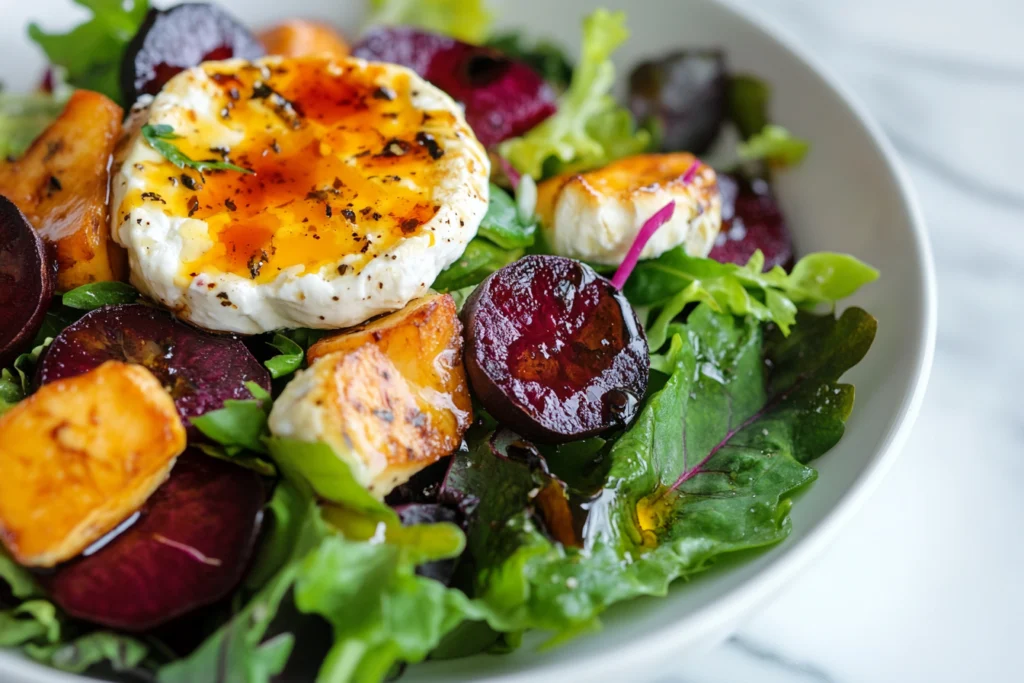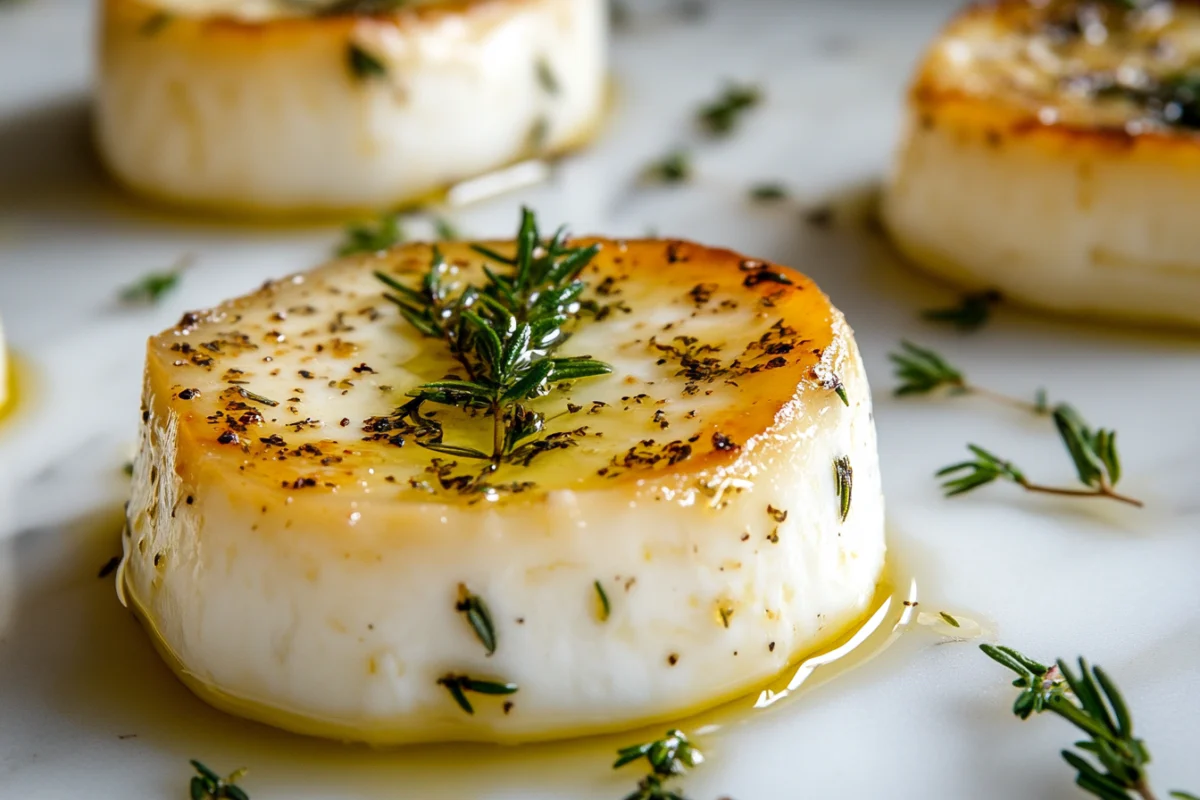Welcome to a deep dive into the world of goat cheese and its irresistible appeal when baked. Goat cheese delivers a tangy, creamy taste that stands out among other varieties. Its unique texture and flavor profile make it ideal for cooking, spreading, or crumbling over salads. In this article, we will explore the core elements of baked goat cheese, from selecting the right herbs to creating crispy toppings that add texture. We will also discuss key nutritional benefits and provide answers to common questions. By the end, you will have a wealth of knowledge and practical tips for crafting an unforgettable dish that will dazzle family, friends, and dinner party guests alike.
The Flavor Profile of Baked Goat Cheese
Goat cheese carries a distinct tang that intensifies when heated. This tanginess often balances perfectly with the cheese’s smooth, creamy base. Baked goat cheese heightens that contrast. The heat pulls out the sharper notes while softening the cheese to a luxurious, spreadable consistency. Many people find that goat cheese, once baked, adopts a texture similar to warm cheesecake—melt-in-your-mouth, yet firm enough to hold its shape.
Goat cheese is made from goat’s milk, which has different fat and protein ratios compared to cow’s milk. Accordingly, the flavor is more pronounced. Because goat’s milk contains smaller fat globules, it tends to create a denser, richer product. This factor becomes especially evident once you bake it. The caramelization that occurs on the surface yields a delicate crust. Meanwhile, the center retains an almost fluffy, whipped sensation that spreads easily on crackers or bread.
Tanginess remains the star, but there is more depth to discover when you add other flavor boosters. Herbs like thyme, rosemary, and basil merge with the cheese’s inherent earthiness. Garlic, sun-dried tomatoes, and a sprinkle of chili flakes can also enhance the experience. Comparatively, sweet elements like honey or figs contrast the savory core. Because goat cheese is versatile, you can pair it with an array of sweet or savory ingredients. This adaptability ensures your final product feels balanced, no matter how many flavor combinations you try.
When enjoying baked goat cheese, you will notice a smooth harmony between the initial sharp bite and the creamy middle. This dynamic quality helps the cheese stand out among typical appetizers. Another benefit is that it remains soft and velvety even after it begins to cool. In essence, the magic of this dish lies in its ability to combine strong tanginess with a tender, melt-in-your-mouth texture. Altogether, baked goat cheese offers a flavor journey that excites the palate with every bite.
Essential Ingredients for Baked Goat Cheese Success

Creating outstanding baked goat cheese involves more than selecting just any cheese. The supporting ingredients, including herbs, spices, and even the olive oil you choose, play an essential role in the final taste and texture. Below, we break down the fundamentals needed to achieve success every time.
First and foremost, you need a quality log of goat cheese. Look for a fresh chevre that is firm enough to hold its shape during baking but soft enough to melt readily. Generally, fresh goat cheese logs come in small to medium sizes. Choose one that smells clean and tangy. A bright white color typically indicates freshness. If you can, sample different varieties to find the one that best matches your desired flavor intensity.
Herbs are your next priority. Rosemary, thyme, and oregano are common favorites. Basil can also add a pop of freshness. Rosemary features a piney, woodsy note, while thyme contributes an earthy, subtle flavor. When these herbs meet the tangy cheese, they infuse it with an aromatic depth. You can use either dried or fresh herbs. However, fresh herbs often deliver a sharper taste and more vibrant presentation.
Spices and seasoning blends form the next layer. Garlic powder or fresh minced garlic complements goat cheese, adding complexity without overpowering. A pinch of smoked paprika imparts a mild smokiness, though you can experiment with hot paprika for a spicier kick. Salt and pepper, of course, remain essential for bringing out the tang in goat cheese. Because goat cheese can be quite salty on its own, taste as you go. Adjust seasoning to achieve a balanced result.
Another vital ingredient is high-quality olive oil. Drizzling a bit over the goat cheese before baking helps promote browning and adds a silky finish. Extra virgin olive oil provides a fruitier taste, while light olive oil carries a more neutral profile. Whichever you choose, ensure it is fresh and stored properly to avoid rancid flavors. You can also try truffle oil or chili-infused olive oil to give your baked cheese a gourmet edge.
In certain recipes, you might include sweet elements like honey or fig jam. This sweet-and-savory interplay can amplify the tanginess of goat cheese. Walnuts, almonds, or pistachios can lend a crunchy topping if you enjoy textural contrast. Ultimately, assembling a well-rounded ingredient list is key to achieving a flavorful dish. Moreover, these additional layers encourage a more interesting mouthfeel and ensure you never tire of the same basic profile.
Step-by-Step Guide to Making Baked Goat Cheese

Crafting a perfect baked goat cheese dish may look sophisticated, but it is surprisingly straightforward. Initially, gather all the tools you need. You will want a baking dish (ceramic or glass works best), parchment paper, or aluminum foil for easy cleanup, and a mixing bowl for your seasoning blend. Having everything on hand speeds up the process and keeps you organized.
Step 1: Preparation
Preheat your oven to around 375°F (190°C). While it warms up, remove the goat cheese log from the refrigerator. Let it rest briefly on the counter so it softens slightly. Meanwhile, mix your chosen herbs, spices, and a drizzle of olive oil in a bowl. If you plan to add nuts or breadcrumbs as a crust, prepare that mixture now by combining them with seasonings. Lightly grease your baking dish or line it with parchment paper. This step prevents any sticking and aids in a quick cleanup afterward.
Step 2: Assembly
Place your goat cheese log on the baking dish. Carefully roll or press the seasoning mix onto the cheese’s surface. If you are using additional toppings like sliced olives or chopped nuts, gently pat them into the cheese. Drizzle a bit more olive oil over the top. This layer of oil helps the cheese develop a lightly golden crust. You can also add a splash of white wine or vegetable broth to the pan for extra moisture and subtle flavor.
Step 3: Baking
Slide the dish into the preheated oven. Bake for about 10 to 15 minutes, depending on the cheese’s size and thickness. Monitor closely in the final few minutes. You want a lightly golden top without letting the cheese overbrown. Overbaking can lead to a grainy texture, so it is best to remove the dish as soon as you see slight browning on the edges.
Step 4: Cooling
Take the cheese out of the oven and let it rest for a minute or two. This short cooldown ensures the flavors settle and the cheese remains intact. If you cut into it immediately, the structure might collapse into an overly melted pool. A brief rest helps maintain that delicate balance between creamy interior and slightly firm exterior.
Step 5: Serving
Transfer the baked cheese to a serving plate or leave it in the baking dish for a more rustic look. Garnish with fresh herbs, a drizzle of honey, or a scattering of dried fruits. Serve it warm, accompanied by crusty bread, crackers, or raw vegetables. You will find the cheese is still quite spreadable and easy to portion out. The step-by-step procedure is that simple. Basically, once you master these fundamentals, you can adapt or expand the recipe with your own twists.
Serving Ideas for Baked Goat Cheese at Every Occasion

Baked goat cheese can seamlessly fit into various dining contexts. Whether you want to create an elegant starter for a dinner party or a simple snack for a movie night, the versatility of goat cheese shines through. Here are several suggestions for turning this dish into a star at your table.
Appetizers and Canapés
When hosting a gathering, few dishes impress more easily than a baked cheese spread. Place a small log of goat cheese in a decorative oven-to-table dish. Surround it with slices of baguette, crostini, or crackers. Add bowls of olive tapenade, roasted peppers, and fruit preserves so guests can customize their bites. Because the cheese is already warm and soft, guests only need to scoop or spread it onto bread. The tangy notes pair nicely with both savory and sweet accompaniments, ensuring broad appeal.
Salads and Sandwiches
Sliced rounds of warm goat cheese can transform a basic salad into a gourmet meal. Consequently, if you are making a beet and arugula salad, a medallion of baked cheese placed on top elevates the dish. The earthy sweetness of beets and the peppery bite of arugula accentuate the cheese’s tang. Drizzle with a light vinaigrette, and you have a restaurant-quality plate. For sandwiches, consider layering baked goat cheese with roasted vegetables like zucchini and eggplant. The creaminess counterbalances the smoky flavors of grilled produce. Alternatively, tuck a piece of warm goat cheese into a baguette with tomato slices and fresh basil for a quick lunch that feels refined.
Main Course Inspirations
Use baked goat cheese as the central protein in a vegetarian main course. Because goat cheese is filling and satisfying, it can anchor a dish when coupled with grains, legumes, and vegetables. For instance, top a bed of lentils or quinoa with baked goat cheese medallions. Drizzle with a tangy vinaigrette for brightness. Another strategy is to serve it with roasted tomatoes, peppers, and onions. The cheese melts slightly over the vegetables, unifying the flavors. Add a side salad, and you have a complete, balanced dinner. You can also incorporate it into a tart or quiche. Line a pastry shell with caramelized onions and top with baked goat cheese slices before adding the egg mixture. The result is a creamy, tangy tart that everyone will remember.
No matter how you choose to serve it, baked goat cheese brings a sophisticated touch. It is a dish that looks upscale yet requires minimal effort. Undoubtedly, these flexible serving ideas will encourage you to experiment further. Whether you prefer sweet, savory, or spicy, goat cheese can adapt and enhance your culinary vision.
How to Store Leftover Baked Goat Cheese
After a gathering, you might find you have a bit of cheese left in the dish. Proper storage ensures you can repurpose this delicious ingredient later. Initially, let the cheese cool. Then transfer it to an airtight container. Refrigerate it promptly to maintain flavor and freshness. If possible, use it within three days for optimal taste.
When you want to enjoy it again, warm it gently. Spread it onto toast or stir it into hot pasta. Leftover baked goat cheese can also be crumbled over salads. The key is to avoid reheating it too aggressively. High heat can change the texture, making it rubbery. Instead, opt for gentle warmth in a microwave or oven, just enough to soften it.
Experimenting with Herb-Infused Baked Goat Cheese
If you love variety, herb-infused goat cheese will delight your palate. Mix chopped rosemary or thyme directly into the cheese before forming it into a log or disc. Alternatively, marinate goat cheese in olive oil mixed with smashed garlic, chili flakes, and herbs for at least an hour before baking. This process imparts a more intense flavor throughout. Likewise, you can roll the cheese in finely chopped basil or parsley. Serve it with fresh tomato slices or a drizzle of balsamic glaze for a Mediterranean-inspired presentation. Baked goat cheese with herb infusions opens a world of possibility, proving that small twists can significantly alter and elevate the taste.
Tips for Creating Crispy Toppings for Baked Goat Cheese
Crispy elements can turn a soft, creamy cheese into a textural feast. Adding a crust or topping to baked goat cheese enhances both presentation and taste. One popular approach is to coat the cheese log with breadcrumbs. Lightly press panko or seasoned breadcrumbs around the cheese before baking. Drizzle with olive oil, and you will end up with a crunchy, golden layer. Another method uses chopped nuts such as pecans or walnuts. This approach provides earthiness as well as a satisfying contrast to the creamy interior.
You can also create more elaborate crusts by combining breadcrumbs with nuts and herbs. For instance, a mixture of panko, crushed almonds, thyme, and a dash of garlic powder yields a robust flavor. Press it onto the cheese and bake until the crust turns golden-brown. The result is a piece of baked goat cheese that crackles delightfully with every bite. Essentially, these toppings allow you to tailor texture to your preference. Keep in mind that a thin drizzle of honey or olive oil helps bind the topping. This ensures even browning and a cohesive finish.
Nutritional Benefits of Goat Cheese
Goat cheese is not just delicious. It also offers a healthy dose of nutrients. One of the main advantages lies in its lower lactose content compared to many cow’s milk cheeses. This feature often makes it easier to digest for individuals who are lactose-sensitive. Additionally, goat cheese tends to have more medium-chain fatty acids, which are metabolized differently from long-chain fats. This unique composition can contribute to more efficient energy usage by the body.
Vitamins and minerals are another highlight. Goat cheese typically contains good amounts of calcium, phosphorus, and vitamin B2. These support bone health and energy metabolism. The cheese also provides protein, critical for muscle repair and growth. Goat cheese offers a slightly tangy profile that may help curb overeating because its strong flavor encourages smaller portions. Consequently, baked goat cheese can be a smart addition to your meal plan, allowing you to enjoy a creamy, indulgent treat that also supplies valuable nutrients.
Moreover, goat cheese often has a different casein composition compared to cow’s milk cheeses. Some people find goat cheese less likely to trigger inflammatory responses. While individual reactions may vary, this factor contributes to goat cheese’s reputation as a more digestible option. Summarily, it merges taste with health benefits, making it a go-to for many who want to expand their cheese repertoire.
Frequently Asked Questions
Does goat cheese melt well in the oven?
Goat cheese does not melt in the same way as cheddar or mozzarella. It softens rather than forming a stretchy layer. Nonetheless, it bakes beautifully. You will see a slight browning on top, and the interior becomes creamier. In a sense, it melts into a luscious, spreadable form without losing its shape entirely.
Can you bake goat cheese?
Absolutely. Baking goat cheese is a popular technique to enhance its flavor and texture. Whether you bake it as a standalone appetizer or layer it into a recipe, it responds well to moderate oven heat. This method yields a warmer, silkier version of the cheese that pairs seamlessly with bread, crackers, or roasted vegetables.
Is goat cheese good for baking?
Indeed, goat cheese is excellent for baking. Its tangy edge intensifies, and the cheese takes on a soft yet stable consistency. You can customize it with various seasonings or crusts, making it suitable for savory tarts, stuffed dishes, or simply served on its own.
Is it OK to heat goat cheese?
Yes, heating goat cheese is perfectly fine. Many people enjoy warming it to amplify its flavor. However, moderate heat is key. Overheating can cause the cheese to lose moisture and become slightly grainy. Keeping the oven temperature around 375°F (190°C) generally works best to preserve creaminess.
Conclusion
In conclusion, baked goat cheese delivers a tangy, creamy, and versatile option for countless recipes. By selecting fresh goat cheese, pairing it with the right herbs, and employing proper baking techniques, you can achieve a dish that delights in both taste and texture. We have explored the critical ingredients, offered step-by-step guidance, and shared tips for adding extra flavors and toppings. We have also highlighted goat cheese’s nutritional benefits, showing why it stands out among other cheeses.
Whether you plan to serve it as an impressive appetizer, a hearty salad topper, or the centerpiece of a main dish, baked goat cheese captures attention. The easy-to-follow methods, variety of topping possibilities, and countless serving ideas ensure that you will never run out of ways to experiment. Undoubtedly, goat cheese’s unique tang keeps guests intrigued and satisfied. Feel free to incorporate it into your next dinner party spread or transform a simple lunch into a gourmet experience. Ultimately, with the guidance provided here, you are fully equipped to create a memorable dish that reflects your personal culinary style.
FOR MORE DELICIOUS RECIPES:
Irresistible Sincronizadas: A Tasty Mexican Favorite
What Is the Secret Ingredient in a Good Burger? Discover the Key to Perfection

